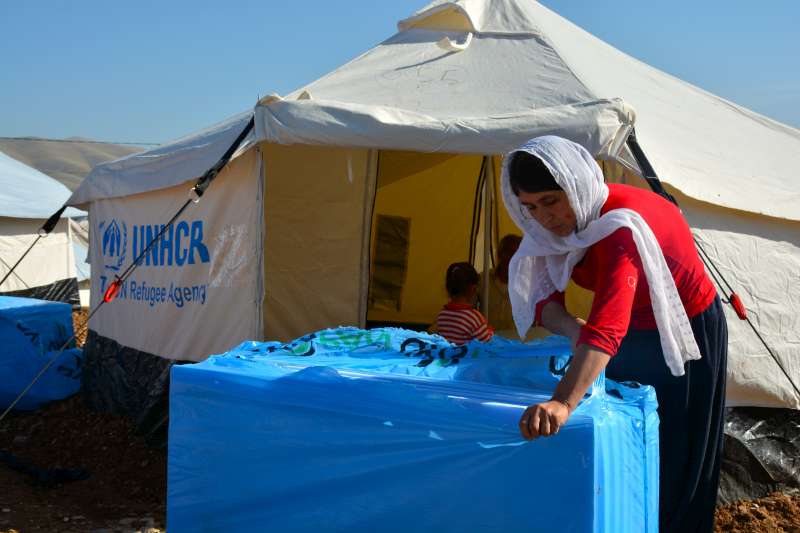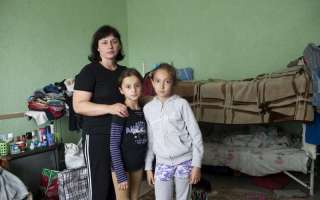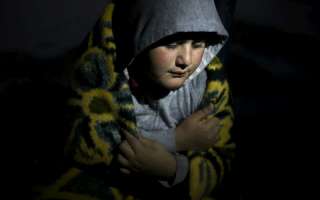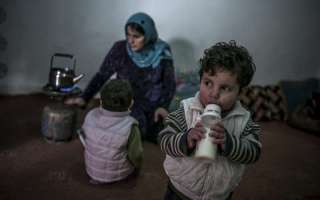
Mother-of-seven Laila opens a box containing insulation packaging that will keep her family warm this winter. © UNHCR/N.Colt
ARBAT, Iraq, December 30 (UNHCR) – More than 3,000 internally displaced Iraqis are living in Arbat camp three months after it opened to shelter to some of the 2 million people uprooted by conflict in northern and central Iraq in 2014.
They comprise some 660 families, including 40-year-old Laila, her husband Khalaf and their seven children. The family from Sinjar fled to the city of Suleymaniyah in northern Iraq’s Kurdistan region in August to escape the deadly advance in other parts of the country of militant forces.
They stayed in a partly built building with no windows or doors, but when temperatures began to drop in early December, and the US$200 monthly rent became too much to pay, Laila and Khalaf opted to move to one of Iraq’s growing number of tented camps.
Thousands of other internally displaced people have been doing the same thing as temperatures continue to drop and the job market contracts. Running short of financial resources, they hope to receive winter assistance in the safety of camps from organizations like UNHCR.
A television, satellite dish, bags of clothing, a tricycle and a refrigerator are piled up outside the two UNHCR tents at Arbat camp that Laila and her family now call home. “Tent camps are for those without money and who have nowhere to go,” says 46-year-old Khalaf, a former construction worker in Sinjar. “Those who complain most about living in camps can usually afford to live elsewhere.”
Here in Arbat, there is water, latrines, electricity, children’s areas and a monthly ration of food. But it is far from ideal. Most such camps across Iraq lack hot water while schools are still in the planning stage. Mud is a near-constant companion.
Arbat is just one of 24 camps for displaced Iraqis now open across the country. Another 17 are under construction, with almost all slated for completion by the end of January. There are more than 160,000 people living in these camps, but that number will likely more than double in the next few weeks.
While most of the displaced have now been moved out of schools, there are still tens of thousands living in unfinished buildings, with relatives, in rented apartments or in collective centres.
As of November, an estimated 40 per cent of the 2 million displaced were living in sub-standard shelter—that’s the population that UNHCR and other aid agencies have prioritized to ensure that they will remain warm and dry through the winter.
“We are in a race against the clock here,” says UNHCR Representative in Iraq Neill Wright. “We are making substantial progress, but the sheer numbers of those in need, and the fact that they are spread out across some 2,000 sites across Iraq, makes it a daunting challenge.”
The weatherproofing of thousands of houses and collective centres is under way, and, since early November, UNHCR has been airlifting to Iraq 25,000 tent insulation kits from a factory in Pakistan. Thousands have been distributed, tent-by-tent, to camp populations. The priority is to help those living in high elevations where the winter snow is falling.
One of those camps is Arbat. Earlier this month, on their move-in day, the Laila and her family received their tent insulation kit. Within 30 minutes they had laid out the polystyrene flooring panels and hung fibre liners along the walls— essentially creating a tent within a tent. Laila says camp life is far from ideal, but this winter, they can plan on being warm and dry.
By Ned Colt in Suleymaniyah, Iraq





